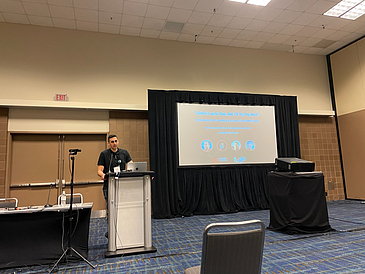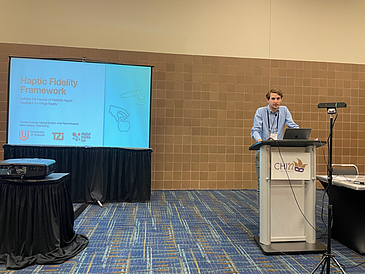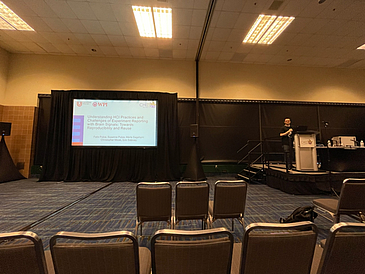The Digital Media Lab was represented with five papers at this year's CHI 2022 in New Orleans. Nima Zargham presented his paper '"I Didn't Catch That, But I'll Try My Best": Anticipatory Error Handling in a Voice Controlled Game' on research in the field of voice assistants, which was a collaboration with Johannes Pfau and Tobias Schnackenberg. He investigated how participants respond to anticipatory error handling by using a game that lets the user direct a herding dog using voice commands. In addition, Nima also presented a poster on individual preferences in personalising voice assistants in a domestic context.
Thomas Münder introduced his "Haptic Fidelity Framework" at CHI2022, which he had developed together with Michael Bonfert, Anke Reinschlüssel and Tanja Döring. The work explores the factors that influence realistic haptic feedback in virtual reality (VR). In addition, he and Anke presented a paper from the VIVATOP project in the form of a poster that showed initial results on the comparison of soft and hard 3D models in the form of livers for interaction with a VR liver surgery planning tool.
Another contribution at CHI2022 was the journal paper "Understanding HCI Practices and Challenges of Experiment Reporting with Brain Signals: Towards Reproducibility and Reuse" written by Susanne Putze together with Felix Putze and Merle Sagehorn from the Cognitive Systems Lab at the University of Bremen and Christopher Micek and Erin Solovey from Worcester Polytechnic Institute. The work describes how EEG signals have been used in HCI to date and presents guidelines on how the information should be reported to achieve greater comparability and reproducibility of results.
The publications are all available in the ACM Digital Library and the presentations are uploaded to YouTube.
Zargham et al. - "I Didn't Catch That, But I'll Try My Best": Anticipatory Error Handling in a Voice Controlled Game
ACM: dl.acm.org/doi/abs/10.1145/3491102.3502115
YouTube: www.youtube.com/watch
Zargham et al. - "I Want It That Way'": Exploring Users' Customization and Personalization Preferences for Home Assistants
ACM: dl.acm.org/doi/abs/10.1145/3491101.3519843
YouTube: www.youtube.com/watch
Muender et al. - Haptic Fidelity Framework: Defining the Factors of Realistic Haptic Feedback for Virtual Reality
ACM: dl.acm.org/doi/abs/10.1145/3491102.3501953
YouTube: www.youtube.com/watch
Muender et al. - Evaluating Soft Organ-Shaped Tangibles for Medical Virtual Reality
ACM: dl.acm.org/doi/abs/10.1145/3491101.3519715
YouTube: www.youtube.com/watch
Putze et al. - Understanding HCI Practices and Challenges of Experiment Reporting with Brain Signals: Towards Reproducibility and Reuse
ACM: dl.acm.org/doi/abs/10.1145/3490554
YouTube: www.youtube.com/watch





